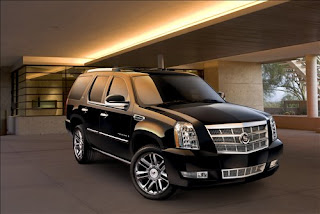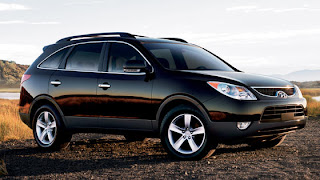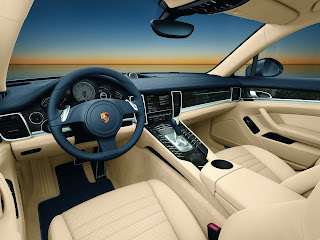Mazda CX-9 2011 merits our approval
Mazda�s CX-9 is one of the company�s most award-winning vehicles, garnering North American Truck of the Year and the Motor Trend Sport Utility of the Year, amongst others. An instant success when it first hit the market in 2007, the CX-9 raised the bar for three-row crossover SUVs. From its dynamic styling and safety to versatility and performance, Mazda�s flagship crossover SUV continues to wow customers and automotive critics alike. Highly refined inside and out for 2010, CX-9 receives redesigned wheels and improved fuel economy for 2011.
Deftly blending sporty driving spirit with seven-passenger crossover utility vehicle (CUV)
practicality, the CX-9 is powered by a 273-horsepower 3.7-liter V6 engine and features standard Roll Stability Control, standard Bluetooth hands free phone and an available advanced Blind Spot Monitoring (BSM) system, which helps see and prevent the unexpected. Other available features include two-position heated front seats, BOSE� audio system, an available Multi Information Display (MID) for audio with rearview camera and available NAVI with Real Time Traffic System.
EMOTIONAL EXTERIOR STYLING Many mid-sized crossover SUVs strive for the utilitarian look. The Mazda CX-9, however, is designed to evoke a strong pride of ownership. Without sacrificing versatility or efficiency, the CX-9 achieves the sophisticated appearance of a vehicle costing two to three times as much. Its smooth and flowing silhouette, prominent wheels and tires, muscular fenders and steeply angled windshield give the CX-9 a dramatic-but-refined look. After a far-reaching cosmetic update in 2010, CX-9 adds new-design 20- and 18-inch wheels for 2011.
CX-9's front end is unmistakably Mazda, with its elegantly sculpted sporty five-point grille and wide, bold bumper. A horizontal streak of chrome floats on the front grille bar, giving a distinctive and high-quality feel. Side windows form a flowing, open and modern greenhouse, allowing clear vision from all seating positions. The unique, trapezoid, dual chrome exhaust pipes accentuate the fine detail put into the design.
CRAFTED AND REFINED INTERIOR STYLING
Once inside the CX-9, the driver is greeted by a neatly organized combination of cylindrical shapes and blacked-out instruments on a T-shaped instrument panel. Brightly edged gauges and indirect blue illumination set a cool mood. Indirect lighting also is embedded in the ceiling for a warm glow. Horizontal elements in areas such as the center panel, door trim and seat design intersect with vertical accents to create the same harmony present in fine furniture.
Interior craftsmanship and attention to detail is visible everywhere. Soft trim is elegantly configured and constructed of top-quality materials and seats have an inviting yet sporty look and feel appropriate to this type of vehicle. The dash panel houses large, clearly marked entertainment and climate controls. The metallic look of the floating door trim-grips reveals the designer�s fine eye for detail.
STRONG, POWERFUL POWERTRAIN
The 2011 CX-9 is powered by a 3.7-liter V6 engine, making the most complex pursuits as easy and as pleasurable as possible. The 60-degree short-stroke V6 is state-of-the-art throughout. Advanced features include a die-cast aluminum block with cast-in iron cylinder liners and aluminum cylinder heads for minimal weight. The valvetrain includes chain-driven dual overhead camshafts for minimal maintenance, four valves-per-cylinder with direct acting bucket-type actuators, and variable intake valve timing. A high 10.3:1 compression ratio maximizes efficiency and power output while the throttle is electronically controlled for instantaneous response.

Two close-coupled catalytic converters cleanse the exhaust without inhibiting power. Computer-aided-engineering analysis was extensively used to configure the cylinder block casting, to shape intake and exhaust ports, and to design the high-volume exhaust system fitted with three large mufflers. Very low back pressure is one of the reasons why the power curve is still ascending at the 6500-rpm redline. In addition, the forged-steel crankshaft is fitted with induction-hardened journals, a full complement of counterweights. Engineering details even extend to a roller-chain cam-drive sprocket lined with rubber for quiet operation.
A power peak of 273 horsepower at 6,250 rpm provides CX-9 with sparkling accelerating and passing performance. The torque curve keeps 250 lb-ft from 3,000 to 6,000 rpm and peaks at 270 lb-ft at 4,250 rpm.
To combine excellent acceleration and high fuel mileage, CX-9 includes an Aisin-supplied six-speed Sport AT automatic transmission with manual-mode as standard equipment. Broad ratios maximize flexibility by providing enthusiastic launch acceleration with quiet cruising. The top two gears are both overdrive ratios.
Front-wheel drive is standard in the Mazda CX-9 for excellent drivability, with Mazda�s Active Torque All-Wheel Drive optionally available. Also used in the CX-7 crossover SUV, this system rapidly adjusts to changing traction needs by monitoring wheel slippage, steering angle, yaw rate, lateral acceleration and available driveline torque. In normal driving, 100-percent of the driving torque is delivered to the front wheels. During aggressive acceleration or when one front wheel is on the verge of slip, a controlled percentage of the available torque is directed to the rear axle.
A power take-off device integrated with the CX-9's transaxle spins a drive shaft attached to an active coupling built into the rear differential. Commanded by a control module, the servo-controlled multi-plate coupling can route from zero up to 50 percent of the available torque to the rear wheels.
CHASSIS ENGINEERED FOR SAFETY AND PERFORMANCE
The CX-9 offers every Mazda safety device, and all as standard equipment. Guiding development principles are:
� Front frame rails that are large in section and as straight as possible.
� A front subframe (supporting the powertrain, suspension, and steering equipment) attached to the unibody at six widely separated points. A forward extension integral to the subframe helps it to more effectively absorb collision energy.
� B-pillars securely anchored to members in the floor and rocker areas with increased cross-section for all load-bearing members.
� Rear frame rails positioned higher and configured as straight as possible.
� Bumper reinforcement manufactured using a hot-stamping technique.
� More than a dozen structural members in the floor and roof pillars made of high-tensile steel. Multiple steel reinforcements in the roof and a triple-H-shaped floor structure help absorb side-impact energy.
� A fuel tank positioned near the middle of the vehicle and surrounded by multiple torque box crossmembers.
� Maximum overlap between the doors and the unibody to minimize side-impact intrusion. Energy absorbing material on front and rear door trim diminishes the transfer of impact loads to occupants.
� Spot welds, laser welding in high-stress areas, and weld bonding (combination of welding and structural adhesives) to improve unibody stiffness.
� Acoustical foam filler applied to internal cavities to block noise transmission from underbody into cabin areas.
� Highly rigid damping sheet applied to large expanses of the floor pan to eliminate resonance and to block road noise.
For CX-9 to wear the Mazda brand symbol, it had to be more than just another crossover SUV. It had to be a true Mazda, embodying the company�s philosophy �Soul of a Sports Car.� And so engineers determined CX-9 had to have an independent suspension on all four corners.
In front, the perimeter frame mounted to the unibody through six rubber isolators supports the powertrain, the engine-speed-sensitive rack-and-pinion power steering, and a low friction strut-type suspension system using coil springs. The multilink rear suspension consists of one trailing arm and three lateral locating links per side. To minimize cargo-compartment intrusion and permit a wider load space, the rear coil spring is positioned between the lower lateral links and the unibody. A damper is located as close as possible to each rear wheel to provide excellent motion control with minimal friction. Anti-roll bars at each end maximize agility and control during assertive driving.
Twenty-inch, V-rated, low-profile radial tires (P245/50R-20) are standard equipment on the top Grand Touring model while Sport and Touring editions roll on P245/60R-18 tires. As a result, CX-9 looks and feels unusually nimble for its size and is the clear class leader for driving pleasure.
EYES IN THE BACK OF YOUR HEAD
The Blind Spot Monitoring (BSM) system supports the driver when changing lanes on roads and highways. At speeds of 20 mph or more, the system monitors areas on both sides of the vehicle to the rear. When a vehicle enters the detection area on either side, the BSM notifies the driver by illuminating a warning light located in the door mirror in the same side. If the driver then activates the turn signal, indicating a move in the same direction, the warning light will flash and the system will also sound an audible alert to immediately inform the driver of the potential danger in changing lanes.
ROOM ENOUGH FOR THE KIDS AND THEIR FRIENDS
The Mazda CX-9 rides on a 113.2-inch wheelbase, one of the longest in the segment, providing easy access to its three-row seating. There�s ample room for adults in every position and sufficient cargo space to accommodate modern American families. Under the sleek exterior is an interior that will impress demanding customers with its space, utility, versatility, and premium features.
To ease accommodations for all drivers, the driver�s seat and steering column move quickly and easily over a long range of adjustment. The 60-40 split second row carries three in comfort and offers approximately five-inches of fore-and-aft slide travel and a reclining backrest. In the 50-50-split third row, the seating position and leg room are among the leaders in the class in numbers and real comfort. Entry to the third row is easy, with nearly 26 inches of access space between the folded second-row seat and the C-pillar. Even with the third row occupied, the CX-9 provides 17.2 cubic feet of cargo capacity, eclipsing many large sedan trunks. Both second- and third-row seats fold flat to allow additional storage all the way up to the back of the front seats.
Extra thought is invested in small details, such as how the CX-9's seat releases are configured. For example, releasing the second row seat in order to enter the third row requires only one simple hand motion to unlatch the seat and move it forward. Likewise, a clever strap attached behind the third row seat�s backrest serves as both a release for folding the seat and a means of pulling it back erect again.
SAFETY WITH ADVANCED TECHNOLOGY
The Mazda CX-9's safety features are highlighted by an advanced Roll Stability Control (RSC) system that uses both body-roll rate and wheel speed sensors to determine when corrective action is necessary. A momentary torque reduction, combined with an automatic brake application, assists in maintaining the CX-9 on an even keel.
Four-wheel ventilated disc-brakes include an Anti-lock Brake System (ABS) to prevent lockup during emergency use. Dual-piston front brake calipers operate in conjunction with 12.6-inch diameter by 1.1-inch thick ventilated rotors. Single-piston rear calipers squeeze 12.8-inch diameter by 0.71-inch thick rotors, also ventilated. Electronic Brake-Force Distribution (EBD) controls front-to-rear distribution of braking forces to take full advantage of available traction during stops. In the event the driver applies the brakes rapidly in an emergency but with insufficient force to engage the ABS function, a brake assist function takes over to stop the vehicle as quickly as possible. To provide drivers with a confident feel during stops, the CX-9's braking system is extra-rigid so that deceleration is more directly proportional to pedal pressure than pedal travel. The payoff with this more linear response is enhanced controllability.
When excessive wheel slippage is detected, a Traction Control System (TCS) automatically reduces driveline torque to help restore traction. Dynamic Stability Control (DSC) automatically applies one or more brakes to minimize under- or over-steer during emergency maneuvers.
In the event an accident is unavoidable, protection is provided by sensor-activated side-curtain airbags which extend from the first to the third row. These inflatable restraints deploy in the event of a lateral collision or a rollover to reduce the likelihood of injury and limb or head ejection. Inflation is maintained for approximately six seconds for maximum effectiveness, although the only way these systems work properly is when used in combination with seatbelts. Pretensioner devices automatically remove slack from the belt system immediately after a moderate or greater frontal collision and load limiters are incorporated to provide some give as the occupant moves forward. The CX-9's front headrests incorporate new design features, which are designed primarily to reduce neck injuries during rear impacts.
CX-9's robust unibody uses the Mazda Advanced Impact-energy Distribution and Absorption System to help protect its cabin from deformation harm in the event of a collision.
A combination of large-section members, some made from high-tensile steel, envelope the passenger compartment to absorb impact energy while guarding against intrusion.
TRIM AND ENTERTAINMENT FEATURES
CX-9 is offered in three trim levels: Sport, Touring and Grand Touring. All models include air conditioning, power windows, power door locks with remote keyless entry, trip computer, cruise control, six air bags, Bluetooth� phone capability and a choice of black or beige interior hues.
The CX-9 Sport is equipped with 18-inch aluminum wheels and tires, halogen headlamps, Bluetooth� hands-free phone capability and cloth upholstery. Power front seat adjusters are optional. Stepping up to the Touring model adds leather seat trim, power front-seat adjusters. The top Grand Touring edition rolls on 20-inch aluminum wheels. It�s also equipped with the aforementioned Touring equipment plus bright exterior door handles, rain-sensing wipers, an anti-theft alarm system, exterior mirrors with turn indicators, a three-position memory driver�s seat, Blind Spot Monitoring system, Homelink auto-dimming rearview mirror, the Mazda Advanced Keyless Entry and Start System, wood-like instrument panel trim, wood-like door trim, indirect blue interior lighting and a silver finish for the side surfaces of the rear console.
CX-9 offers as optional features a factory towing package, power sunroof, BOSE� audio system, power lift gate, and a rear-seat entertainment system. (The rear-seat entertainment system is packaged with the upgraded BOSE� audio system and includes a 115-volt AC power outlet.) Navigation is available as a stand-alone option (on Grand Touring models) and includes a DVD navigation system, and back-up monitor. The back-up monitor system is equipped with a wide-angle camera, which improves the field of vision, allowing for a wider view of objects or people that may be behind the vehicle.
All 2011 Mazdas come with a roadside assistance program. With a call to a toll-free number, owners can access roadside assistance 24 hours a day, 365 days a year throughout the United States and Canada. In addition, a comprehensive three-year/36,000-mile warranty covers every part on the vehicle except those subject to normal wear. Also, all 2011 models receive a five-year/60,000 mile powertrain warranty and a five-year/unlimited-mileage corrosion warranty.






































